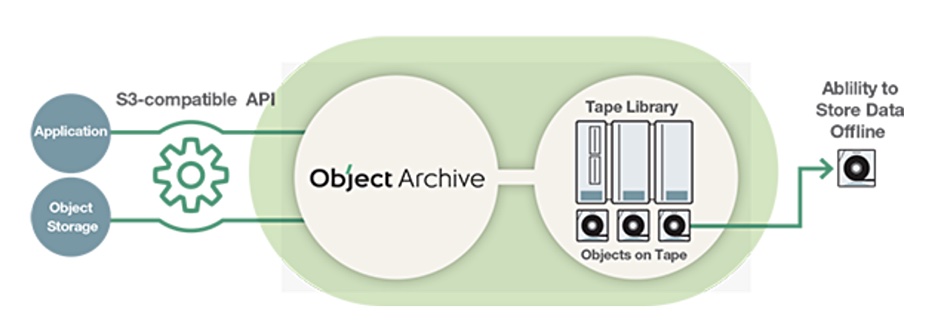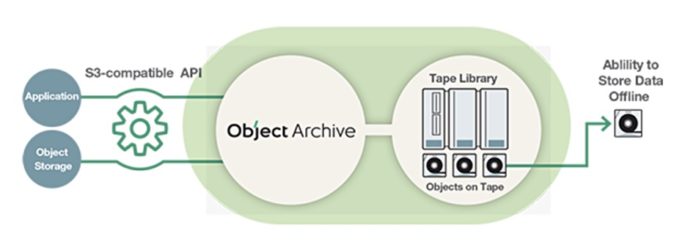- Update: Scality Zenko is the S3 server inside Fujifilm’s Object Archive. 24 June 2020.
- Update: Cloudian and the Object Archive added. 9 June 2020.
Fujifilm is paving the way for tape cartridges and libraries to become object storage archives.
Traditionally files from backup software are stored sequentially on magnetic tape for long-term retention. The last major innovation in tape storage access was LTFS, the Linear Tape File System, in 2011. This provides a file:folder interface to tape cartridges and libraries, with a drag and drop method for adding or retrieving files.
Now Fujifilm has developed a method for transferring objects and their metadata from disk or SSD drives to a tape system. This means tape can be used as an archive medium for object data.
Fujifilm’s new open source file format, OTFormat, enables objects and metadata to be written to, and read from, tape in native form.
The company’s Object Archive software uses OTFormat and an S3 API interface to provide the framework for an object storage tape tier – a software-defined tier, as Fujifilm puts it.
Update: Scality’s Zenko is the S3 server inside the Object Archive.

This tape tier can be an on-premises tape library. Fujifilm said storing petabytes of object data is much cheaper on tape drives than on drives or SSDs. It is also cheaper than the public cloud. However, tape’s slow access speed makes it suitable only for archiving low access rate objects or for object storage backup where slow restoration times are acceptable.
According to a Fujifilm White Paper, tape has a 4x data reliability superiority over disk drives. Tape also provides a literal air gap between the network and the tape cartridges when the latter are offline. This provides immunity from ransomware and other malware attacks, and a reliable means of recovering ransomeware-encrypted data.

Fujifilm is a maker of LTO tape; the current generation is LTO-8 and 12TB raw capacity per cartridge, 30TB compressed. The LTO roadmap extends to LTO-12 with 192TB raw capacity, 480TB compressed. LTO-12 tapes will hold up to 16 times more data than LTO-8 cartridges. There’s lots of capacity headroom, in other words.
No UI or data mover
Fujifilm had not revealed at time of publication a user interface and data mover for its Object Archive. Such an UI/data mover is needed to select older and low-access objects from a disk or SSD-based object store, and move them to a tape system. It would also present a list of objects on the tape system and a means of retrieval.
Fujifilm perhaps needs one or more third parties to provide object backup and restore capabilities. There is a long list of potential partners. Speaking of which …. Jerome Lecat, Scality’s CEO, when asked about Fujifilm’s Object Archive, told us: “Unfortunately I cannot tell you anything more specific today, but watch our news in the coming weeks, especially around Zenko.”
Cloudian and the Object Archive
Cloudian CEO Michael Tso tells us: “We know a lot about this. About 3 years ago, Fujifilm’s Japan based product team reached out to us to partner with them for this product. They use HyperStore as their reference S3 platform for their internal development and test, we acted as their advisor on architecture and S3 API design/compatability. We also hosted them in our US office multiple times, and are engaged with Fujifilm US team as well.”
“We like Fujifilm’s team, their product, we’ve supported their journey. And yes, HyperStore can tier into it.
“I think this product is interesting in a few ways:
- S3 is THE standard – they didn’t implement some multi-protocol translation gateway, or their own dialect of S3 (like some other tape vendors), they built S3 natively into the box.
- Object is the present – their data layout on tape is optimized for object. That’s a really big deal because (a) it’s a lot of work and (b) it helps resiliency and efficiency. They went to all this work because object is the present, file/block are the past.
- Object Stores need multi-cloud – OnPremises/Dark site cold archive is a real use case. HyperStore has native multi-cloud data management, so we simply plug in Fujifilm boxes as another “cloud target”, tier data in/out based on lifecycle policies. HyperStore’s single namespace can cover data in multiple clouds. All metadata stays in HyperStore so users can browse and search their entire namespace whether the actual data is in HyperStore, in a deep archive tape box, or in a public cloud.
This information’s means that Cloudian is ready to rock and roll with the Object Archive. We await the forthcoming news about its availability.








